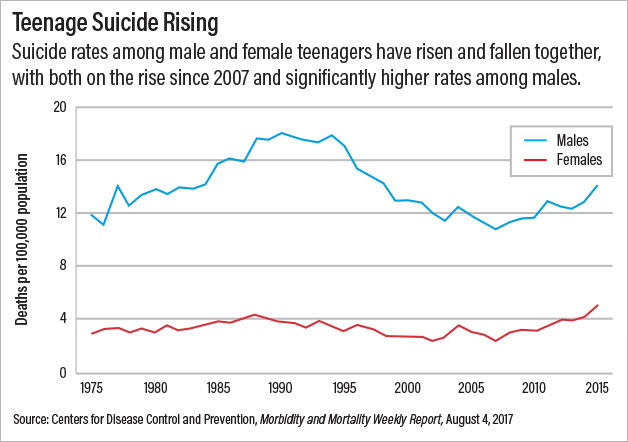Local Culture Influences Suicidal Contagion: a Look at One Upscale American School
Abstract
A closed environment of competitive achievement and suppression of help seeking contributed to a contagion of suicide.
“[Michelle] never felt like she could be perfect in her own eyes, and she had explained this to me just a week and a half before she died. She was telling me, ‘No matter how many people tell me that I’m skinny or pretty or whatever, it doesn’t matter because it matters what I think.’ … Even though on the outside it’s like [she’s] super athletic, varsity athlete, stellar grades, headed for a great college to play lacrosse, that is what it looks like from the outside, and pretty and skinny and all of those things, but to her, … she felt like she wasn’t doing everything right. … That was not very long before [her suicide].”
Those are the words of “Molly,” now a young adult, recalling a best friend who died by suicide. Both young women were students at a highly regarded public high school in an upscale community—one whose reputation is such that families relocate so their children can attend there.
It is also a school where 15 current or former students have died by suicide since 2000, and three other friends or close acquaintances of students have taken their lives since 2005. In the 2005-2017 period, there were also three suicide “clusters,” in which decedents had ties with one another and died within a short period of one another.

Anna Mueller, Ph.D., says that the example of “Poplar Grove” demonstrates how suicide prevention needs to address the local social and cultural factors that influence mental health.
At the 2020 virtual fall conference titled “Suicide, Culture, and Community,” sponsored by the Erikson Institute for Education and Research at Austen Riggs, Anna Mueller, Ph.D., presented findings from an in-depth study of the culture at “Poplar Grove High” (a pseudonym), including comments from students, parents, and mental health professionals in the community. Mueller is an associate professor in the Department of Sociology at Indiana University.
Mueller’s study paints a vivid portrait of a local community highly conscious of itself as one where students are expected to excel, but one where even its most admirable traits—such as tight social cohesion—have produced a culture toxic to mental health. The portrait of Poplar Grove offers insights into how culture broadly impacts suicidality and the specific ways in which local cultural and social idiosyncrasies can produce contagion in the form of suicide clusters.
“The socially connected, homogenous, and narrow culture has generated additional pressure for youth and increased emotional distress and psychological pain, along with suppression of help seeking,” Mueller said. “Combined with repeated exposure to suicide and the interpretation of suicide as a means to escape [that culture], it has produced a disproportionately high rate of suicide and amplified young people’s vulnerability to suicide.”
‘All the Bad Stuff Gets Covered Up’
Poplar Grove is a wealthy suburban community of fewer than 50,000 people, more than 90% of whom are White. Between December 2013 and December 2016, Mueller and colleagues undertook a field study of the Poplar Grove High School and community. They individually interviewed 45 community members, including current and former students, parents, mental health professionals, clergy, and other professionals in the community.
They also collected comments and observations from 15 focus groups; many who participated in individual interviews also participated in a focus group. A total of 98 community members were interviewed.

For comparison, they also interviewed 20 young adults aged 18 to 32 who lived outside of Poplar Grove and had no connection to the community or to the suicides there but had been close to someone in their lives who died by suicide. “We wanted to understand the experience of suicide bereavement more generally and what it is that is unique about Poplar Grove and the repeated exposure to suicide there in a socially cohesive and culturally coherent place,” Mueller said.
She presented her findings in a series of excerpted comments from interview participants that painted a stark and poignant picture of life in Poplar Grove, one that differed markedly from the perspectives expressed in the comparison group.
From Douglas (all names are pseudonyms), a mental health worker: “The expectation and the performance of students at Poplar Grove High School and the whole cluster that feeds into Poplar Grove have been one of athletic excellence, academic excellence, and I use the word ‘expectation’ on purpose because the kids impose much of that on themselves. But there’s also a community expectation that we are Poplar Grove and that we are going to achieve.”
From Shannon, a student at Poplar Grove: “I don’t wanna sound cocky, but I tend to be exactly what the Poplar Grove ideal is. ... Like I said, I’m in [student government], team captain, varsity sport. … but I still go out every single weekend.”
‘I Haven’t Been Anywhere Else’
In this pressure cooker of competition and achievement, young people also expressed a sense of entrapment in the culture. Scott told interviewers he had to make a conscious decision to reject the culture of Poplar Grove. “I think it’s not a good culture. … If I start a family, I won’t start it here.”
He added, “I think we’re so pressured to achieve that we’ve forgotten that this is like one small segment of our entire lives. Not that it isn’t important. I know that high school is important, and I do get those feelings, like ‘Oh, if I don’t pass this test then I’m going to wind up homeless.’ I think I don’t like that that’s the mindset that I go to. … I wish I could change it. I can’t. I don’t know what it’s like in any other places. I haven’t been anywhere else.”
With few or no exits from the local culture, young people at Poplar Grove are also not encouraged to seek help—a truth endorsed by both students and mental health professionals in the community. “All the bad stuff gets covered up,” said Hannah. “So, nobody wants to be like ‘I have an issue.’ And nobody wants to come out and be honest about it. Kids cover it up and try to act like they are doing well in school and they are being the Poplar Grove kid that they are supposed to be. So it gets covered up, and then when it gets to the point where it’s so bad that somebody would consider suicide, it’s too late.”
Mueller said the toxic mix of competitive achievement, entrapment in the culture, and suppression of help seeking demonstrates how local cultural idiosyncrasies can produce a social contagion in the form of suicide.
“Evidence-based suicide prevention is undermined when we don’t account for these social and local cultural roots of suicide,” she said. “We need to pair interventions to help kids in crisis with upstream strategies that focus on building a happier and healthier world for young people—ideally preventing them from even reaching that moment of crisis.” ■



